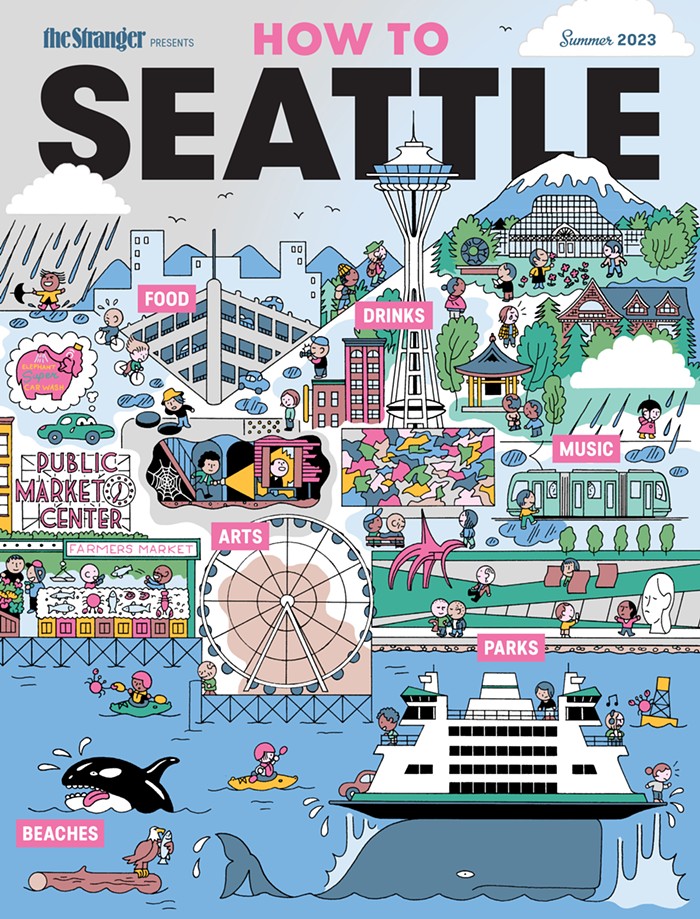Airplanes soar overhead and helicopters slice up the sky just above the Georgetown Steam Plant, where Satori Group and theater collective ARTBARN have set We Remain Prepared. After directors Jess K. Smith and Caitlin Sullivan lay out the ground rules for the performance (watch your head/step, if an actor barrels toward you: move), the plant's big doors open wide.
Inside, humungo Dr. Seuss machinery rises up from rough concrete floors. A blast of warm jazz blows us back to the early 20th century. Narrow staircases and catwalks connect boiler rooms to bathrooms, offices to coal rooms, and Authorized Zones to Unauthorized Zones.
Frank B. Gilbreth engineered and designed the steam plant in 1907, but the Skagit River Hydroelectric Project rendered the place obsolete only a decade or so later. Until it was fully decommissioned in 1970, the city kept the plant operational as an emergency power source. Now it's being used as a teaching facility and apparently a place to do up some art stuff.
We Remain Prepared grows out of the plant's history, drawing not only on some of its historical details but also on the particular sadness of its obsolescence. Gilbreth (Amber Wolfe) owns the company and hands down complex management strategies to plant supervisor Powell (Charles Leggett), who upholds them with unfailing loyalty. Despite Powell's apparent hard-assedness, he spends his evenings listening to melancholy love songs and writing letters. Gray (played with infectious enthusiasm by Carol Louise Thompson) is a gung-ho newbie who makes art out of her surroundings during her off hours. Kimmel (Brandon J. Simmons) is a mysterious but true-blue worker who believes there's a dragon in the ash room.
Gingerly shepherded by hard-hat-wearing docents, the audience follows the trio of steam plant workers as they strive to achieve the Gilbreth Ideal: "Grace through efficiency and efficiency through effort." Tasks include running up and down stairs to check valves and tighten bolts, and also performing mechanical movements choreographed by Alice Gosti, which artfully emphasize the intimacy between factory workers and the machines they operate. As a reward, the crew receives shiny paper clips called "happiness minutes."
The setting works for and against the play. Shuffling around from scene to scene spurred within me the childlike urge to touch everything. This urge was at times more compelling than the action of the play and the slowly developing relationships between the characters. The playwright, directors, and set designers clearly accounted for this curiosity, though, and they use it to create tension. Looking closely at certain props provides clues that foreshadow later scenes and deepened my understanding of characters, and one of the play's most moving moments centered on a pile of old parts I'd written off as junk.
The critique of labor conditions felt welcome and dated at the same time. Aldous Huxley's essay "Time and the Machine" kept coming to mind. In that piece, Huxley argues that the industrialized world runs on factory time and not the more natural cosmic time. "We have a new consciousness, but it has been purchased at the expense of the old consciousness," he writes. What do we gain with this new consciousness? A wealth of things we may or may not need. What do we lose? Our chill. Our leisure is commodified, and we're all trapped by a capitalist system that both creates and feeds off our unhappiness.
Pickers and packers at Amazon warehouses and the fish decapitators at canneries live on factory time, and this play precisely prefigures the sadness of that moment when those jobs get automated and those people are told to go train for the "jobs of the future" but without any help. But the difference between steam plant workers then and the guy who packs up our dildos and fungal creams now is that the steam plant worker could expect a middle-class income and could get another plant job. The packer will become a robot and will struggle to find contract jobs.
Those who have trained for what used to be middle-class jobs now work in the "gig economy," in the high-risk boom-and-bust world of start-up culture, or in the high-skill/low-pay world of necessary jobs (social work, teaching, etc.). They run on internet time, on social-media time. Their leisure isn't commodified. It's an opportunity to do the freelance work they need to keep their heads just above the poverty line.














